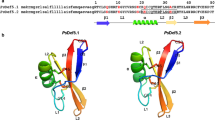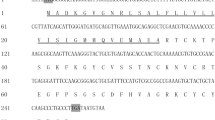Abstract
Plant defensins are small basic peptides of 5–10 kDa and most of them exhibit antifungal activity. In a sunflower resistant to broomrape, among the three defensin encoding cDNA identified, SF18, SD2 and HaDef1, only HaDef1 presented a preferential root expression pattern and was induced upon infection by the root parasitic plant Orobanche cumana. The amino acid sequence deduced from HaDef1 coding sequence was composed of an endoplasmic reticulum signal sequence of 28 amino acids, a standard defensin domain of 50 amino-acid residues and an unusual C-terminal domain of 30 amino acids with a net positive charge. A 5.8 kDa recombinant mature Ha-DEF1 corresponding to the defensin domain was produced in Escherichia coli and was purified by means of a two-step chromatography procedure, Immobilized Metal Affinity Chromatography (IMAC) and Ion Exchange Chromatography. Investigation of in vitro antifungal activity of Ha-DEF1 showed a strong inhibition on Saccharomyces cerevisiae growth linked to a membrane permeabilization, and a morphogenetic activity on Alternaria brassicicola germ tube development, as already reported for some other plant defensins. Bioassays also revealed that Ha-DEF1 rapidly induced browning symptoms at the radicle apex of Orobanche seedlings but not of another parasitic plant, Striga hermonthica, nor of Arabidopsis thaliana. FDA vital staining showed that these browning areas corresponded to dead cells. These results demonstrate for the first time a lethal effect of defensins on plant cells. The potent mode of action of defensin in Orobanche cell death and the possible involvement in sunflower resistance are discussed.







Similar content being viewed by others
Abbreviations
- Dm-AMP1:
-
Dahlia merckii antimicrobial peptide1
- ES-MS:
-
Electro-spray mass spectrometer
- FDA:
-
Fluorescein diacetate
- Ha-DEF1:
-
Helianthus annuus defensin protein1
- IMAC:
-
Immobilized metal affinity chromatography
- Rs-AFP2:
-
Raphanus sativus antifungal peptide2
- RT-PCR:
-
Reverse transcriptase-polymerase chain reaction
References
Aerts AM, François IEJA, Bammens L, Smets B, Winderickx J, Accardo S, De Vos DE,Thevissen K (2006) Level of M(IP)2C sphingolipid affects plant defensin sensitivity, oxidative stress resistance and chronological life-span in yeast. FEBS Lett 580:1903–1907
Benharrat H, Boulet C, Theodet C, Thalouarn P (2005) Virulence diversity among branched broomrape (O. ramosa L.) populations in France. Agronomie 25:123–128
Domon C, Evrard JL, Herdenberger F, Pillay DT, Steinmetz A (1990) Nucleotide sequence of two anther-specific cDNAs from sunflower (Helianthus annuus L.). Plant Mol Biol 15:643–646
El-Halmouch Y, Benharrat H, Thalouarn P (2006) Effect of root exudates from different tomato genotypes on broomrape (O. aegyptiaca) seed germination and tubercle development. Crop Protect 25:501–507
Elmorjani K, Lurquin V, Lelion A, Rogniaux H, Marion D (2004) A bacterial expression system revisited for the recombinant production of cystine-rich plant lipid transfer proteins. Biochem Biophys Res Commun 316:1202–1209
Fossdal CG, Nagy NE, Sharma P, Lonneborg A (2003) The putative gymnosperm plant defensin polypeptide (SPI1) accumulates after seed germination, is not readily released, and the SPI1 levels are reduced in Pythium dimorphum-infected spruce roots. Plant Mol Biol 52:291–302
Hu X, Bidney DL, Yalpani N, Duvick JP, Castra O, Folkerts O, Lu G (2003) Overexpression of a gene encoding hydrogen peroxide-generating oxalate oxidase evokes defense responses in sunflower. Plant Physiol 133:170–181
Iacomi-Vasilescu B, Avenot H, Bataillé-Simoneau N, Laurent E, Guénard M, Simoneau P (2004) In vitro fungicide sensitivity of Alternaria species pathogenic to crucifers and identification of Alternaria brassicicola field isolates highly resistant to both dicarboximides and phenylpyrroles. Crop Protect 23:481–488
Johansson T, Le Quere A, Ahren D, Soderstrom B, Erlandsson R, Lundeberg J, Uhlen M, Tunlid A (2004) Transcriptional responses of Paxillus involutus and Betula pendula during formation of ectomycorrhizal root tissue. Mol Plant Microbe Interact 17:202–215
Labrousse P, Arnaud MC, Serieys H, Berville A, Thalouarn P (2001) Several mechanisms are involved in resistance of Helianthus to Orobanche cumana Wallr. Ann Bot 88:859–868
Lay FT, Anderson MA (2005) Defensins–components of the innate immune system in plants. Curr Protein Pept Sci 6:85–101
Lay FT, Brugliera F, Anderson MA (2003) Isolation and properties of floral defensins from ornamental tobacco and petunia. Plant Physiol 131:1283–1293
Letousey P, de Zélicourt A, Vieira Dos Santos C, Thoiron S, Monteau F, Simier P, Thalouarn P, Delavault P (2007) Molecular analysis of sunflower resistance mechanisms to Orobanche cumana. Plant Pathol (in press). doi 10.1111/j.1365–3059.2007.01575.x
Liang H, Yao N, Song JT, Luo S, Lu H, Greenberg JT (2003) Ceramides modulate programmed cell death in plants. Genes Dev 17:2636–2641
Mabrouk Y, Zourgui L, Sifi B, Delavault P, Simier P, Belhadj O (2007) Some compatible Rhizobium leguminousarum strains in peas decrease infections when parasitized by Orobanche crenata. Weed Res 47:44–53
Matusova R, Rani K, Verstappen FWA, Franssen MCR, Beale MH, Bouwmeester HJ (2005) The strigolactone germination stimulants of the plant-parasitic Striga and Orobanche spp. are derived from the carotenoid pathway. Plant Physiol 139:920–934
Mortimer RK, Johnston JR (1986) Genealogy of principal strains of the yeast genetic stock center. Genetics 113:35–43
Osborn RW, De Samblanx GW, Thevissen K, Goderis I, Torrekens S, Van Leuven F, Attenborough S, Rees SB, Broekaert WF (1995) Isolation and characterisation of plant defensins from seeds of Asteraceae, Fabaceae, Hippocastanaceae and Saxifragaceae. FEBS Lett 368:257–262
Pérez-De-Luque A, Jorrin JV, Cubero JI, Rubiales D (2005a) Orobanche crenata resistance and avoidance in pea (Pisum spp.) operate at different developmental stages of the parasite. Weed Res 45:379–387
Pérez-De-Luque A, Rubiales D, Cubero JI, Press MC, Scholes J, Yoneyama K, Takeuchi Y, Plakhine D, Joel DM (2005b) Interaction between Orobanche crenata and its host legumes: unsuccessful haustorial penetration and necrosis of the developing parasite. Ann Bot 95:935–942
Richard C, Drider D, Elmorjani K, Marion D, Prevost H (2004) Heterologous expression and purification of active divercin V41, a class IIa bacteriocin encoded by a synthetic gene in Escherichia coli. J Bacteriol 186:4276–4284
Rubiales D, Pérez-De-Luque A, Cubero JI, Sillero JC (2003a) Crenate broomrape (Orobanche crenata) infection in field pea cultivars. Crop Protect 22:865–872
Rubiales D, Pérez-De-Luque A, Joel DM, Alcantara C, Sillero JC (2003b) Characterization of resistance in chickpea to crenate broomrape (Orobanche crenata). Weed Sci 51:702–707
Selitrennikoff CP (2001) Antifungal proteins. Appl Environ Microbiol 67:2883–2894
Serghini K, Pérez de Luque A, Castejon-Munoz M, Garcia-Torres L, Jorrin JV (2001) Sunflower (Helianthus annuus L.) response to broomrape (Orobanche cernua Loefl.) parasitism: induced synthesis and excretion of 7-hydroxylated simple coumarins. J Exp Bot 52:2227–2234
Sperling P, Heinz E (2003) Plant sphingolipids: structural diversity, biosynthesis, first genes and functions. Biochim Biophys Acta Mol Cell Biol Lipids 1632:1–15
Terras FRG, Eggermont K, Kovaleva V, Raikhel NV, Osborn RW, Kester A, Rees SB, Torrekens S, Van Leuven F, Vanderleyden J, Cammue BP, Broekaert WF (1995) Small cysteine-rich antifungal proteins from radish: their role in host defense. Plant Cell 7:573–588
Terras FRG, Schoofs HME, De Bolle MFC, Van Leuven F, Rees SB, Vanderleyden J, Cammue BPA, Broekaert WF (1992) Analysis of two novel classes of plant antifungal proteins from radish (Raphanus sativus L.) seeds. J Biol Chem 267:15301–15309
Thevissen K, Ferket KKA, François IEJA, Cammue BPA (2003) Interactions of antifungal plant defensins with fungal membrane components. Peptides 24:1705–1712
Thevissen K, Osborn RW, Acland DP, Broekaert WF (2000) Specific binding sites for an antifungal plant defensin from dahlia (Dahlia merckii) on fungal cells are required for antifungal activity. Mol Plant Microbe Interact 13:54–61
Thevissen K, Terras FRG, Broekaert WF (1999) Permeabilization of fungal membranes by plant defensins inhibits fungal growth. Appl Environ Microbiol 65:5451–5458
Thomma BPHJ, Cammue BPA, Thevissen K (2002) Plant defensins. Planta 216:193–202
Urdangarin MC, Norero NS, Broekaert WF, De La Canal L (2000) A defensin gene expressed in sunflower inflorescence. Plant Physiol Biochem 38:253–258
Vieira Dos Santos C, Letousey P, Delavault P, Thalouarn P (2003) Defense gene expression analysis of Arabidopsis thaliana parasitized by Orobanche ramosa. Phytopathology 93:451–457
Acknowledgments
This work was supported by a grant from the Ministry of Research and Technology of France and partly by the Ouest-genopole and INRA. We thank S. Delgrange, S. Rezé and A. Lelion for technical assistance.
Author information
Authors and Affiliations
Corresponding author
Rights and permissions
About this article
Cite this article
de Zélicourt, A., Letousey, P., Thoiron, S. et al. Ha-DEF1, a sunflower defensin, induces cell death in Orobanche parasitic plants. Planta 226, 591–600 (2007). https://doi.org/10.1007/s00425-007-0507-1
Received:
Accepted:
Published:
Issue Date:
DOI: https://doi.org/10.1007/s00425-007-0507-1




